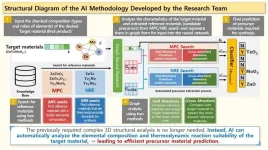(Press-News.org) A new UCLA Health study has discovered in mouse models that genes associated with repairing mismatched DNA are critical in eliciting damages to neurons that are most vulnerable in Huntington's disease and triggering downstream pathologies and motor impairment, shedding light on disease mechanisms and potential new ways to develop therapies.
Huntington’s disease is one of the most common inherited neurodegenerative disorders that typically begins in adulthood and worsens over time. Patients begin to lose neurons in specific regions of the brain responsible for movement control, motor skill learning, language and cognitive function. Patients typically live 15 to 20 years after diagnosis with symptoms worsening over time. There is no known cure or therapy that alters the course of the disease.
The cause of Huntington's disease was discovered over three decades ago--a "genetic stutter" mutation involves repeats of three letters of the DNA, cytosine-adenine-guanine (CAG), in a gene called huntingtin. Healthy individuals usually have 35 or fewer CAG repeats, but people inherited with mutation of 40 or more repeats will develop the disease. The more CAG repeats a person inherits, the earlier the disease onset occurs. However, how the mutation causes the disease remains poorly understood.
A longstanding enigma in the Huntington's disease is how the mutated protein derived from the huntingtin gene is present in every cell of the body, but the disease appears to selectively affect certain types of neurons in a few brain regions. This mystery is shared between Huntington's disease and many other neurodegenerative brain disorders, including Alzheimer's disease, Parkinson's disease, and amyotrophic lateral sclerosis (ALS), albeit different types of neurons are vulnerable to degeneration in each disorder. Solving this mystery could hold insights into disease mechanisms and therapies.
Recently a human genetic study uncovered about a dozen DNA regions in the genome that harbors "modifiers" for Huntington's disease, which are DNA variants that could hasten or delay the onset of the disease by up to a few years. Intriguingly, these regions contain multiple genes involved in repairing DNA mismatches. However, the mechanistic connections between mismatch DNA repair and selective neuronal vulnerability in Huntington's disease remained unknown.
The new study from UCLA Health and Jane and Terry Semel Institute for Neuroscience and Human Behavior at UCLA, published in the journal Cell, reveals that a distinct subset of mismatch repair genes are key drivers of Huntington’s disease and how the disease affects specific types of neurons.
“We demonstrate the same DNA mismatch repair genes that are modifiers in the Huntington's disease patients can drive fast-paced disease processes only in the most vulnerable neurons in a mouse model, leading to a cascade of disease phenotypes,” said lead author Dr. X. William Yang, professor of the UCLA Health Department of Psychiatry and Biobehavioral Sciences and the Terry Semel Chair in Alzheimer's Disease Research and Treatment at the Semel Institute.
Yang and colleagues used Huntington’s disease model mice with 140 CAG repeats (called Q140 model), as such long repeats are necessary to observe disease features in a mouse model. They asked whether genetically altering nine HD patient-derived modifier genes, including six mismatch repair genes, in this mouse model could alter any disease phenotypes. Although an HD mouse model lacks overt neuronal cell death, possibly due to the short lifespan of a mouse, they exhibit multiple disease-like phenotypes that are highly selective to the HD vulnerable neurons. They include the dysregulation of the expression of thousands of genes in the striatal neurons and an accumulation of clumps of mutant Huntingtin protein (called aggregates), which are a hallmark of pathology in HD patient brains. The aggregates happen first in the striatal neurons and later in the cortical neurons, and they progressively worsen over time, mimicking the progression of the disease. Remarkably, HD mice lacking a subset of mismatch repair genes, especially Msh3 and Pms1, correct the vast majority of the gene expression deficits in this mouse model. Moreover, they partially or fully prevent the mutant Huntingtin aggregate pathology throughout the brain.
Besides molecular and pathological benefit, the study also shows targeting Msh3 can ameliorate locomotor and gait deficits, improve neuronal synaptic protein levels, and reduce glial cell over-reactivity.
"We were surprised to see the potent and sustained effects of targeting these mismatch repair genes in HD mice -- the benefit lasts up to 20 months of age in a mouse, which would be comparable to about 60 years in humans", said Yang. "Our study suggests that these genes are not just disease modifiers, as suggested by the previous studies, but are genetic drivers of Huntington's disease."
How might mismatch repair genes alter the disease process in HD? Recent studies suggest the mutant Huntingtin CAG repeats are unstable in adult brain cells, especially in the vulnerable neurons such as the striatal medium spiny neurons (MSNs), and such an expansion is associated with gene expression changes and possibly neuronal cell death. However, the role of modifier genes in the repeat expansion in brain cells remain untested in patients. In mouse models, previous studies show that mismatch repair genes confer high levels of instability in the striatum, the most vulnerable brain region, but only a subset of repeats appear to expand beyond the inherited allele.
"We are puzzled why stopping a subset of CAG repeats from expanding in Msh3- or Pms1-deficient HD mice could lead to a benefit in all striatal neurons", said Nan Wang, a co-first author in the study.
Wang designed an experiment to purify the nuclei DNA only from the MSNs, the most vulnerable neurons in the striatum, and measure the CAG DNA repeat sizes for mutant Huntingtin. She found that surprisingly the repeat sizes for the entire MSN population are increasing at a linear rate of +8.8 repeats per month, with repeats well over 220 repeats by 12months of age. If other striatal neuronal types or non-neuronal cells are included in this assay, the majority of repeats remains at 140. Impressively, deleting one copy of Msh3, the CAG expansion rate in MSNs reduced to +2.3 repeats/month, and deleting both copies of Msh3, the rate is essentially stable at 0.35 repeats/month.
Importantly, these findings also reveal that mutant huntingtin aggregation requires a threshold of CAG expansion to 150, and gene expression dysregulation is also highly associated with the expanded CAG length in the MSNs.
"These remarkable results demonstrate that a subset of mismatch repair genes is driving disease in vulnerable neurons because they confer the fastest rate of CAG repeat expansion in these neurons", said Yang, "and our study provides mechanistic links that help to bridge modifier genes from patients, mismatch repair gene driven repeat expansion, and selective neuronal vulnerability in HD".
The study provides important therapeutic implications. First, the study tested 6 DNA mismatch repair genes and only four of them appear to strongly (Msh3 and Pms1) or moderately (Msh2 and Mlh1) modify pathogenesis in HD mouse model. Interestingly, these genes together encode a minor mismatch repair complex, which is conserved from yeast to human, but its function in yeast remains unknown. Moreover, although 4 of the 6 mismatch repair genes are associated with cancer in human, Msh3 and Pms1 are not known to be associated with cancer. This study also showed that aged Msh3 and Pms1 mice are free of notable molecular or pathological changes. Thus, the study reveals that targeting genes encoding this minor mismatch repair complex, either by reducing the expression levels of Msh3, Pms1, or the complex formation, could be therapeutic in HD.
Moreover, this study shows targeting these mismatch repair genes could benefit multiple brain regions, including brain areas with early-onset (striatum) or late-onset (cortex) pathologies. Thus, it implies therapies targeting this disease mechanism could be helpful both at delaying onset or slowing the progression of the disease.
Additionally, this study demonstrates that an HD mouse model, and its constellation of molecular, pathological and behavioral phenotypes could constitute a platform to test novel therapeutics targeting the HD modifier genes involved in CAG repeat expansion or mechanisms improving the resilience or health of HD vulnerable neurons.
Inherited dynamic DNA repeat mutations affect over 30 neurological disorders and several of them also found mismatch repair genes that could affect the repeat instability or disease severity. The mechanistic findings and model platform could help discover therapies for these other disorders as well.
Other study authors are Nan Wang, Shasha Zhang, Peter Langfelder, Lalini Ramanathan, Fuying Gao, Mary Plascencia, Raymond Vaca, Xiaofeng Gu, Linna Deng, Leonardo E. Dionisio from Center for Neurobehavioral Genetics of Semel Institute and Department of Psychiatry and Biobehavioral Sciences at UCLA; Ha Vu, Emily Maciejewski and Jason Ernst from Department of Biological Chemistry at UCLA; Steve Horvath from Department of Human Genetics at David Geffen School of Medicine at UCLA; and Brinda C. Prasad, Thomas F. Vogt, Jeffrey S. Aaronson, and Jim Rosinski from CHDI Management, Inc.
This research is supported by CHDI Foundation, Inc. Other support includes NINDS/NIH grant (R01NS113612), Hereditary Disease Foundation, and donations to X. W. Yang Lab from the HD patient families.
END
Mystery solved: New study reveals how DNA repair genes play a major role in Huntington's disease
UCLA Health researchers say findings uncover novel disease mechanisms and pave new ways to develop therapies
2025-02-11
ELSE PRESS RELEASES FROM THIS DATE:
Harvard Pilgrim Health Care Institute announces launch of Center for Sepsis Epidemiology and Prevention Studies (SEPSIS)
2025-02-11
Boston, MA – The Harvard Pilgrim Health Care Institute is proud to announce the launch of the Center for Sepsis Epidemiology and Prevention Studies (SEPSIS). This pioneering center of excellence is dedicated to advancing understanding, prevention, and management of sepsis, a life-threatening condition caused by a dysregulated immune response to infection.
The SEPSIS Center will be led by Dr. Chanu Rhee and Dr. Michael Klompas, internationally recognized leaders in sepsis surveillance, prevention, treatment, and policy. Both serve as faculty at Harvard Medical School and the Harvard Pilgrim Health Care Institute and bring a wealth of expertise and a shared commitment ...
New perspectives for personalized therapy of brain tumors
2025-02-11
Scientists from the German Cancer Research Center (DKFZ) and ShanghaiTech University have developed an innovative method for growing brain tumors of individual patients in the laboratory that mimic the original structure and the molecular property of the parental tumor as closely as possible. Drug tests in this model were found to correlate very well with actual patient responses, making it a valuable method for investigating therapies.
Tumor organoids, i.e. mini-tumors grown from surgical material in the culture dish, ...
IEEE researchers provide mathematical solutions to study 2D light interaction in photonic crystal lasers
2025-02-11
Laser diodes are semiconductors that generate light and amplify it using repeated reflection or ‘optical feedback’. Once the light has achieved desirable optical gain, laser diodes release it as powerful laser beams. Photonic crystal surface-emitting lasers (PCSELs) are advanced laser diodes where the optical gain is typically distributed laterally to the propagating light within a photonic crystal (PC) structure. They differ from traditional lasers by separating gain, feedback, and emission functions, offering scalable single-mode power and innovative ...
New joint project to investigate quantum repeaters designed to provide for secure quantum communication networks of the future
2025-02-11
There are reports of IT sabotage, cyber espionage, and other acts of hybrid warfare almost every day. Communication networks based on quantum physics could help eliminate threats of this kind. Researchers throughout Germany have already been working on developing those networks based on quantum repeaters for several years. In January 2025, the German Federal Ministry of Education and Research (BMBF) started funding a new research project, entitled Quantenrepeater.Net (QR.N), which aims to demonstrate the viability of quantum repeaters over test networks outside the protected lab environment. The BMBF will be providing a total of EUR 20 million over three years. ...
PhRMA Foundation welcomes two board members
2025-02-11
The PhRMA Foundation announced the appointment to its Board of Directors of Dr. John C. Reed, MD, PhD, Executive Vice President of Innovative Medicine R&D at Johnson & Johnson (J&J), and Dr. Donatello Crocetta, MD, MBA, Chief Medical Officer and Head of Medical Communities at UCB.
The PhRMA Foundation is a 60-year-old nonprofit that fosters biopharmaceutical innovation and value-driven health care by investing in the frontiers of research. The Foundation catalyzes the careers of promising researchers through competitive, ...
Microbiome as a potential key to better treatment: Clinical study on new therapy for Crohn's disease
2025-02-11
A special liquid diet, known as exclusive enteral nutrition, is an essential therapy for Crohn's disease. Patients consume only this formula for six to eight weeks, completely avoiding solid foods. However, the exact reasons why this is helpful were previously unclear. Researchers at the Technical University of Munich (TUM) and the LMU University Hospital Munich have now been able to decipher the mechanism behind this dietary therapy. Based on these results, they are launching a clinical study combining dietary therapy with faecal microbiome transfer to further enhance ...
AI predicts the precursor materials needed for material synthesis
2025-02-11
Researchers in Korea have developed a technology that automatically identifies the necessary precursor materials to synthesize specific target materials.
A joint research team led by Senior Researcher Gyoung S. Na from the Korea Research Institute of Chemical Technology (KRICT) and Professor Chanyoung Park from the Korea Advanced Institute of Science and Technology (KAIST) has developed an AI-based retrosynthesis methodology that predicts the required precursor materials solely based on the chemical formula of the target material without expensive material descriptors ...
International Shark Attack File Report: Unprovoked shark bites plummeted in 2024
2025-02-11
2024 was an exceptionally calm year for shark bites. Worldwide, there were only 47 unprovoked attacks, down 22 from the previous year and well below the 10-year average of 70. Four of last year’s attacks resulted in fatalities, also a significant reduction from recent years.
The International Shark Attack File, maintained by the Florida Museum of Natural History, provides data on what are considered unprovoked bites, defined as incidents in which a person does not initiate contact with a shark. Instances in which a person intentionally or unintentionally initiates contact, including spearfishing and releasing sharks ...
Ketamine for mental health should only be provided by trained professionals
2025-02-11
CHICAGO – The anesthetic ketamine is being hailed as a breakthrough therapy for people with post-traumatic stress disorder (PTSD), treatment-resistant depression and other mood disorders. But the drug does have side effects – some potentially life-threatening – and should only be prescribed and administered by trained health care professionals to ensure the patient’s safety, according to new guidance released by the American Society of Anesthesiologists (ASA).
Long valued for its role in sedation and anesthesia during medical procedures, ...
Study takes a ‘bite’ out of shark depredation using citizen science
2025-02-11
Shark depredation is a hot-button issue in recreational fishing, as anglers face off against these stealthy ocean bandits. These underwater thieves snatch fish straight off the line, often leaving nothing but scraps – or a broken leader – as evidence of their heist.
The Southeast, a major hub for saltwater fishing, is a depredation “hot spot” due to high fishing activity. While fisheries managers in the United States monitor shark depredation in commercial fisheries, efforts to evaluate these interactions in recreational fishing have been limited.
With Florida’s recreational ...
LAST 30 PRESS RELEASES:
For teens, any cannabis use may have impact on emotional health, academic performance
School meals could unlock major gains for human and planetary health
Menopause hormone therapy does not appear to impact dementia risk
Signature patterns of brain activity may help predict recovery from traumatic brain injury
Dresden study uncovers new key mechanism in cancer cells
New species are now being discovered faster than ever before, study suggests
Cannabis-based products show limited short-term benefit for chronic pain, with increased risk of adverse effects
Cannabis products with more THC slightly reduce pain but cause more side effects
Clearing the brain of aging cells could aid epilepsy and reduce seizures
Brain injuries linked with potential risk of suicide, new study finds
New technique lights up where drugs go in the body, cell by cell
New study finds movement of fishing fleets can reveal shifts in marine ecosystems
Embargoed: New evidence points to potential treatment for vascular dementia
Study uncovers disrupted brain balance in alcohol dependence
Working in groups can help Republicans and Democrats agree on controversial content moderation online
Structural findings reveal how distinct GPCR ligands create different levels of activation
Anything-goes “anyons” may be at the root of surprising quantum experiments
UC review: Maximizing workplace opportunity for veterans
From generation to complex control: Metasurfaces make perfect vortex beams "within reach"
Thin-film lithium niobate-based detector: recent advances and perspectives
Exploring why some people may tend to persistently make bad choices
How cells balance their protein levels
Nirsevimab vs RSVpreF vaccine for RSV–related hospitalization in newborns
Effectiveness and impact of maternal RSV immunization and nirsevimab on medically attended RSV in US children
AI gives scientists a boost, but at the cost of too many mediocre papers
Next-generation vision model maps tree growth at sub-meter precision
Genes aren’t destiny for inherited blindness, study shows
MIT study: High-fat diets make liver cells more likely to become cancerous
Exposure to multiple fine particulate matter components and incident depression in the US Medicare population
Risk of burdensome health care spending over time in the US
[Press-News.org] Mystery solved: New study reveals how DNA repair genes play a major role in Huntington's diseaseUCLA Health researchers say findings uncover novel disease mechanisms and pave new ways to develop therapies



